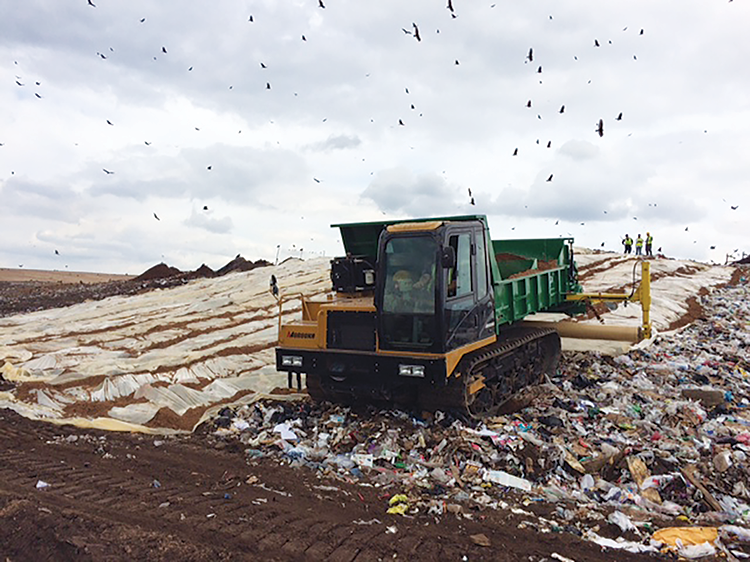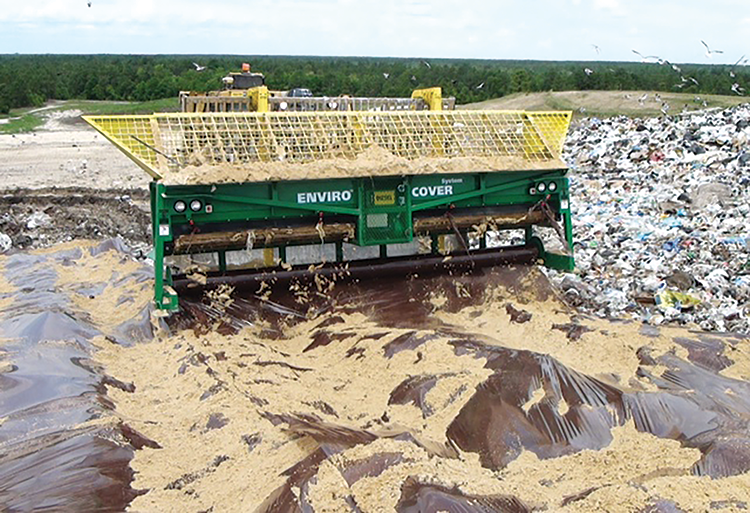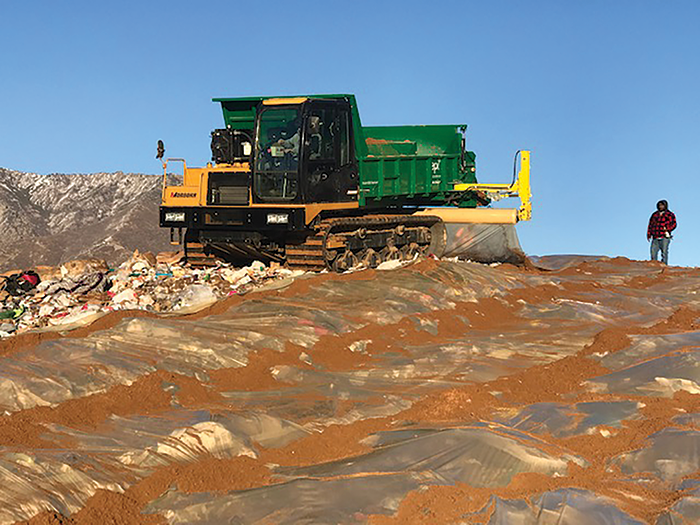If your site is faced with a regulatory mandate to use soil, you may want to explore non-reusable polyethylene film as its performance exceeds that of soil while still saving airspace.
By J.D. Mohr
For landfill operators, managing odors can be a daunting task. When selecting an alternative daily cover (ADC), one must carefully consider the composition of the ADC to analyze its permeability. Common types of ADC include but are not limited to non-reusable polyethylene film, spray on materials, temporary tarps, green waste, or revenue generating waste other than soil. Permeation performance can vary immensely with these different types of ADC. Striking a balance between costs and cover composition can be challenging; every site has unique circumstances dictating its options.
To illustrate the significance of this we can think about how we manage our own household waste. From the kitchen to the curb, we prefer to use a polyethylene bag for its superior odor containment properties. Imagine if we used a porous netted bag to keep our household waste confined, the odors would quickly escape and cause the entire room to smell. I only use this example to show the relationship between ADC permeability and odors escaping at the working face.

Photos courtesy of EPI Enviro Cover.
Regulators Mandating Soil Cover
Soil has long been considered the optimum form of cover to meet EPAs daily cover requirements. In some cases, landfills are forced by state regulators to cover with soil when odors become a pervasive problem. When compared with ADCs, some regulators feel that soil is the most effective form of cover due to its permeability factors and coverage characteristics. Based on scientific data, an argument can be made that soil is not the most effective cover for containing odor and vapors in the landfill.
Non-Reusable Polyethylene Versus Soil Cover
At present, there is no widely accepted direct method to test the capability of an ADC material to control odors in the field. The American Society for Testing and Materials (ASTM) recommends in the ASTM Standard Guide D6523, Standard Guide for Evaluation and Selection of Alternative Daily Covers for Sanitary Landfills: “For slurries and geo-synthetics, an odor control test should be conducted to assess performance. For these materials, a permeation test, Test Method E96, is suggested, correlating the movement of water vapors through an ADC layer to the movement of odor layers through such layer. Water vapor loss through the ADC should be less than 3,000g/m2 per day” (Source Mark Cadwallader, M.S.).
The permeability of water vapor through the 1.5 mil film is calculated to be roughly 5.5 x 10-17.1 This is about 1/1,00,000,000th of typical permeability of methane through daily soil cover of 5.7 x 10-8. This is making assumptions about typical temperature, humidity, and pressure. Thicker films provide a longer pathway to water vapor loss and have a more superior odor control capability. Based on permeability data, a non-reusable polyethylene film deployed over the working face is far more effective than soil in mitigation of landfill emissions. Containing emissions is one thing, reducing the generation of emissions requires limiting water infiltration as well.

Keep Gas in and Water Out
A non-reusable polyethylene film can also provide a barrier for the entrance of rainwater. This helps prevent the excessive generation of leachate that produces more odors from uninhibited garbage decay. Accelerated by leachate, organic wastes decay into organic acids and other odorous compounds, thereby generating strong odors.
Make the Working Face Part of Your Odor Control Plan
When I speak with landfill managers about odor, they typically point to not having enough gas wells to effectively manage the production of gas. While additional wells are a very large part of mitigating odor complaints, the working face is normally given less gravitas. When faced with odor issues, it is prudent to take a close look at how your cover operations are handled. Do you receive any highly odorous waste such as sludge, and how much? What time of the day do you receive the offending loads? Have you used drone technology or air modeling to pinpoint methane sources? All these factors and more should be routinely proactively evaluated to ensure proper odor mitigation. A solid waste
recurring audit while simultaneously using a low permeability ADC can help manage odors at the working face.

Explore Your Options
There are many different ADCs on the market today. This article compared a non-reusable polyethylene film to soil for the purposes of understanding how permeability can impact emissions at the working face. More data is needed on the permeability of other types of ADCs to make a head-to-head comparison. However, polyethylene film is known for having a very low permeability. When compared to soil the film is significantly more effective at creating a vapor barrier between the waste and the environment. When comparing temporary tarps you can achieve similar containment results, however, the tarps are not left in place like the film. With film, the next days waste is deposited on top of the film for continuous containment. If your site is faced with a regulatory mandate to use soil, you may want to explore non-reusable polyethylene film as its performance exceeds that of soil while still saving airspace. | WA
J.D. Mohr is Business Development Executive for EPI Enviro Cover. He has more than 16 years in the waste industry as a business owner and waste industry consultant. J.D. can be reached at (317) 316-2922, e-mail [email protected] or visit www.envirocoversystem.com.
Note
1.Using data supplied by Enviro Cover.
